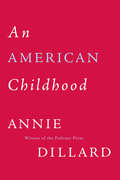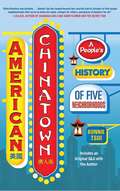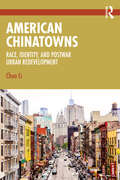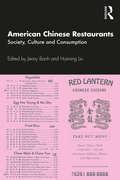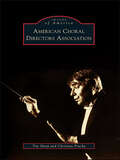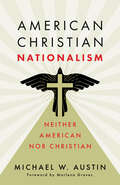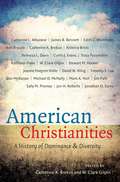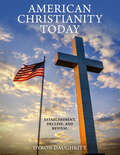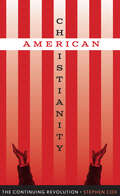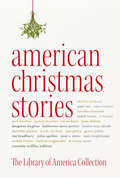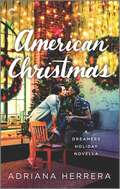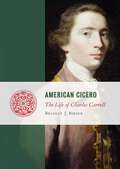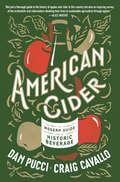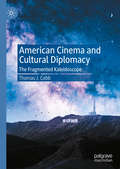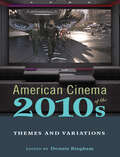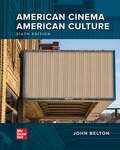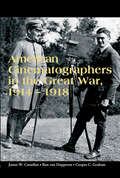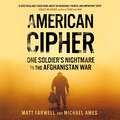- Table View
- List View
American Childhood
by Annie DillardA book that instantly captured the hearts of readers across the country, An American Childhood is Pulitzer Prize-winning author Annie Dillard's poignant, vivid memoir of growing up in Pittsburgh in the 1950s.
American Childhood: A Photographic History
by Todd BrewsterA remarkable collection of over 200 stunning photographs of children—from the Civil War era to the present—that captures the ever-changing experience of childhood throughout American history.Did Americans &“invent&” childhood? Author Todd Brewster believes we did, or at least childhood as &“a period of life cordoned off from that of full maturity, covered with a veil of protection, and subject to a program of nurture.&” That&’s the inspiration behind this rich, compelling volume of rarely seen historical images drawn from the photography collections at the Library of Congress, The Metropolitan Museum of Art, the New York Public Library, and the Magnum Photo Agency as well as dozens of other archives, flea markets, and antique shops. The result is a carefully curated paean to American youth: 200-plus photos from all parts of American history, joined by a series of deeply insightful essays on the topic of the American child. American Childhood reveals American children of all types: white, Black, gay, straight, poor, middle-class, upper class, in cities, on farms, at work, at play, lost in reverie, posing for the camera, or captured in their innocence as the lens gazes at them from afar. Some of them would go on to fame: A young Mark Twain is here. So is a juvenile Thomas Edison, Shirley Temple, Lady Gaga, Sammy Davis Jr., Truman Capote, and dozens of others. Can you see the spark of genius in the life of a child? Brewster thinks so. Still, most subjects here are unknown; in many cases a photograph may be the only public trace they have left behind. Both a powerful study of American childhood and a beautiful gallery of extraordinary photography, American Childhood is a terrific addition to an under-appreciated part of American history.
American Childhoods
by Joseph E. IllickSelected by Choice magazine as an Outstanding Academic TitleThe experiences of children in America have long been a source of scholarly fascination and general interest. In American Childhoods, Joseph Illick brings together his own extensive research and a synthesis of literature from a range of disciplines to present the first comprehensive cross-cultural history of childhood in America.Beginning with American Indians, European settlers, and African slaves and their differing perceptions of how children should be raised, American Childhoods moves to the nineteenth century and the rise of industrialization to introduce the offspring of the emerging urban middle and working classes. Illick reveals that while rural and working-class children continued to toil from an early age, as they had in the colonial period, childhood among the urban middle class became recognized as a distinct phase of life, with a continuing emphasis on gender differences.Illick then discusses how the public school system was created in the nineteenth century to assimilate immigrants and discipline all children, and observes its major role in age-grouping children as well as drawing working-class youngsters from factories to classrooms. At the same time, such social problems as juvenile delinquency were confronted by private charities and, ultimately, by the state. Concluding his sweeping study, the author presents the progeny of suburban, inner-city, and rural Americans in the twentieth century, highlighting the growing disparity of opportunities available to children of decaying cities and the booming suburbs.Consistently making connections between economics, psychology, commerce, sociology, and anthropology, American Childhoods is rich with insight into the elusive world of children. Grounded firmly in social and cultural history and written in lucid, accessible prose, the book demonstrates how children's experiences have varied dramatically through time and across space, and how the idea of childhood has meant vastly different things to different groups in American society.
American Chinatown: A People's History of Five Neighborhoods
by Bonnie TsuiCHINATOWN, U.S.A.: a state of mind, a world within a world, a neighborhood that exists in more cities than you might imagine. Every day, Americans find "something different" in Chinatown's narrow lanes and overflowing markets, tasting exotic delicacies from a world apart or bartering for a trinket on the street -- all without ever leaving the country. It's a place that's foreign yet familiar, by now quite well known on the Western cultural radar, but splitting the difference still gives many visitors to Chinatown the sense, above all, that things are not what they seem -- something everyone in popular culture, from Charlie Chan to Jack Nicholson, has been telling us for decades. And it's true that few visitors realize just how much goes on beneath the surface of this vibrant microcosm, a place with its own deeply felt history and stories of national cultural significance. But Chinatown is not a place that needs solving; it's a place that needs a more specific telling. In American Chinatown, acclaimed travel writer Bonnie Tsui takes an affectionate and attentive look at the neighborhood that has bewitched her since childhood, when she eagerly awaited her grandfather's return from the fortune-cookie factory. Tsui visits the country's four most famous Chinatowns -- San Francisco (the oldest), New York (the biggest), Los Angeles (the film icon), Honolulu (the crossroads) -- and makes her final, fascinating stop in Las Vegas (the newest; this Chinatown began as a mall); in her explorations, she focuses on the remarkable experiences of ordinary people, everyone from first-to fifth-generation Chinese Americans. American Chinatown breaks down the enigma of Chinatown by offering narrative glimpses: intriguing characters who reveal the realities and the unexpected details of Chinatown life that American audiences haven't heard. There are beauty queens, celebrity chefs, immigrant garment workers; there are high school kids who are changing inner-city life in San Francisco, Chinese extras who played key roles in 1940s Hollywood, new arrivals who go straight to dealer school in Las Vegas hoping to find their fortunes in their own vision of "gold mountain." Tsui's investigations run everywhere, from mom-and-pop fortune-cookie factories to the mall, leaving no stone unturned. By interweaving her personal impressions with the experiences of those living in these unique communities, Tsui beautifully captures their vivid stories, giving readers a deeper look into what "Chinatown" means to its inhabitants, what each community takes on from its American home, and what their experience means to America at large. For anyone who has ever wandered through Chinatown and wondered what it was all about, and for Americans wanting to understand the changing face of their own country, American Chinatown is an all-access pass.
American Chinatowns: Race, Identity, and Postwar Urban Redevelopment
by Chuo LiAmerican Chinatowns: Race, Identity, and Postwar Urban Redevelopment offers a captivating exploration of the vibrant yet contested landscapes of Chinatowns across the United States.Through a critical and nuanced lens, Li examines how postwar urban redevelopment, racial dynamics, and identity politics have profoundly transformed these iconic neighborhoods. Blending rich historical research with sharp analysis, this book uncovers the interplay of race, urban planning ideologies, and social equity, shedding light on how Chinatowns navigate resilience and reinvention amid shifting urban paradigms. Li’s work highlights the tension between cultural preservation and modernization, exploring the built environment alongside community-driven spatial activism to reveal how these urban spaces persist as sites of resistance, identity, and transformation. American Chinatowns is a compelling study of cultural landscape, urban justice, and the politics of city-making.This book is essential reading for scholars, urbanists, and anyone intrigued by the intersection of race, identity, and the evolving narratives of America’s cities. This book invites readers to rethink the meaning of place, heritage, and equity in the urban fabric.
American Chinese Restaurants: Society, Culture and Consumption
by Haiming Liu Jenny BanhWith case studies from the USA, Canada, Chile, and other countries in Latin America, American Chinese Restaurants examines the lived experiences of what it is like to work in a Chinese restaurant. The book provides ethnographic insights on small family businesses, struggling immigrant parents, and kids working, living, and growing up in an American Chinese restaurant. This is the first book based on personal histories to document and analyze the American Chinese restaurant world. New narratives by various international and American contributors have presented Chinese restaurants as dynamic agencies that raise questions on identity, ethnicity, transnationalism, industrialization, (post)modernity, assimilation, public and civic spheres, and socioeconomic differences. American Chinese Restaurants will be of interest to general readers, scholars, and college students from undergraduate to graduate level, who wish to know Chinese restaurant life and understand the relationship between food and society.
American Choral Directors Association (Images of America)
by Tim Sharp Christina PruchaAmerican Choral Directors Association (ACDA) was formed in Kansas City, Missouri, on February 24, 1959, by 35 choral directors from around the United States. They aimed to create an organization that would meet the professional needs of all choir directors. To achieve this goal, they made the promotion of excellence in choral music through performance, composition, publication, research, and teaching their central purpose. In addition, ACDA strives through arts advocacy to elevate choral music�s position in American society. From the original steering committee to today�s leaders, this central purpose continues to drive ACDA�s development. Among the ways that ACDA has promoted excellence in choral music are national and division conventions featuring the best choirs in the world, awards given to individuals who have in some way contributed to the art of choral music, state workshops and clinics, and honor choirs and commissioned works. Each generation that has passed through ACDA has left its indelible mark. The first generation built the foundation and gave ACDA its purpose. The second generation gave ACDA its independence and voice. The third generation leads the organization into a new and more globally connected world. And through it all, ACDA remains true to promoting choral music excellence.
American Christian Nationalism: Neither American nor Christian
by Michael W. AustinMichael W. Austin shows how nationalism is contrary to American values and Christian virtues—and offers us a better form of civic engagement. In this brief, thought-provoking book, Michael W. Austin turns his keen mind for ethics toward the crisis currently facing our democracy: the rise of American Christian nationalism. Austin first accessibly explains the meaning and history behind nationalism. He then systematically shows how the ideology contradicts American values like liberty, equality, and justice as well as Christian virtues like humility, faith, hope, and love. Ultimately, he argues that the Beloved Community, first developed by Martin Luther King Jr. and others, offers a better model for an authentically Christian and American community. Readers frustrated by partisan strife will find a faithful guide in Austin&’s thoughtful volume.
American Christianities
by Catherine A. Brekus W. Clark GilpinFrom the founding of the first colonies until the present, the influence of Christianity, as the dominant faith in American society, has extended far beyond church pews into the wider culture. Yet, at the same time, Christians in the United States have disagreed sharply about the meaning of their shared tradition, and, divided by denominational affiliation, race, and ethnicity, they have taken stances on every side of contested public issues from slavery to women's rights. This volume of twenty-two original essays, contributed by a group of prominent thinkers in American religious studies, provides a sophisticated understanding of both the diversity and the alliances among Christianities in the United States and the influences that have shaped churches and the nation in reciprocal ways. American Christianities explores this paradoxical dynamic of dominance and diversity that are the true marks of a faith too often perceived as homogeneous and monolithic. Contributors:Catherine L. Albanese, University of California, Santa BarbaraJames B. Bennett, Santa Clara UniversityEdith Blumhofer, Wheaton College Ann Braude, Harvard Divinity SchoolCatherine A. Brekus, University of Chicago Divinity SchoolKristina Bross, Purdue UniversityRebecca L. Davis, University of DelawareCurtis J. Evans, University of Chicago Divinity SchoolTracy Fessenden, Arizona State University Kathleen Flake, Vanderbilt University Divinity SchoolW. Clark Gilpin, University of Chicago Divinity SchoolStewart M. Hoover, University of Colorado at BoulderJeanne Halgren Kilde, University of MinnesotaDavid W. Kling, University of MiamiTimothy S. Lee, Brite Divinity School, Texas Christian UniversityDan McKanan, Harvard Divinity SchoolMichael D. McNally, Carleton CollegeMark A. Noll, University of Notre DameJon Pahl, The Lutheran Theological Seminary at PhiladelphiaSally M. Promey, Yale UniversityJon H. Roberts, Boston UniversityJonathan D. Sarna, Brandeis University
American Christianity Today: Establishment, Decline, and Revival
by Dyron DaughrityIs the United States a Christian nation? When Europeans first explored and colonized North America, they brought generations of religious conflict and a variety of Christianities with them. The Christian faith has flowered in the United States but has become extremely complex. American Christianity Today gives readers a panoramic view of America's Christians. It makes an excellent text for university courses. In this book, historian Dyron Daughrity clearly and carefully explores a rich array of topics, including: Christianity's interaction with politics; Evangelicalism (and its complexities); Small, rural churches, as well as inner-city ones; Popular American pilgrimage sites; Christian film and music; Women leaders; Megachurches; Pressing issues of today, including race, civil rights, immigration, abortion, and climate change; Roman Catholicism: America's largest denomination; Eastern Orthodoxy; Mormonism, Jehovah's Witnesses, and Seventh-Day Adventists; Youth programs; Christian universities; The Black church tradition, and The rise of the “nones" (those claiming no religion). As a special feature, this book includes extensive photography that illustrates and supports Daughrity's well-researched chapters, helping readers to reflect on the depth and breadth of American Christianity today.
American Christianity: The Continuing Revolution (Discovering America)
by Stephen CoxChristianity takes an astonishing variety of forms in America, from churches that cherish traditional modes of worship to evangelical churches and fellowships, Pentecostal churches, social-action churches, megachurches, and apocalyptic churches—congregations ministering to believers of diverse ethnicities, social classes, and sexual orientations. Nor is this diversity a recent phenomenon, despite many Americans’ nostalgia for an undeviating “faith of our fathers” in the days of yore. Rather, as Stephen Cox argues in this thought-provoking book, American Christianity is a revolution that is always happening, and always needs to happen. The old-time religion always has to be made new, and that is what Americans have been doing throughout their history. American Christianity is an engaging book, wide ranging and well informed, in touch with the living reality of America’s diverse traditions and with the surprising ways in which they have developed. Radical and unpredictable change, Cox argues, is one of the few dependable features of Christianity in America. He explores how both the Catholic Church and the mainline Protestant churches have evolved in ways that would make them seem alien to their adherents in past centuries. He traces the rise of uniquely American movements, from the Mormons to the Seventh-day Adventists and Jehovah’s Witnesses, and brings to life the vivid personalities—Aimee Semple McPherson, Billy Sunday, and many others—who have taken the gospel to the masses. He sheds new light on such issues as American Christians’ intense but constantly changing political involvements, their controversial revisions in the style and substance of worship, and their chronic expectation that God is about to intervene conclusively in human life. Asserting that “a church that doesn’t promise new beginnings can never prosper in America,“ Cox demonstrates that American Christianity must be seen not as a sociological phenomenon but as the ever-changing story of individual people seeking their own connections with God, constantly reinventing their religion, making it more volatile, more colorful, and more fascinating.
American Christianity: The Continuing Revolution (Discovering America)
by Stephen CoxThis wide-ranging study examines the ever-evolving forms of Christianity in the US, and why this constant reinvention is a vital part of American faith. Christianity takes an astonishing variety of forms in America: from traditional chapels to modern megachurches, from evangelical fellowships to social-action groups, and from Pentecostal faith to apocalyptic movements. Stephen Cox argues that radical and unpredictable change is one of the few dependable features of Christianity in America. It is in a necessary and ongoing state of revolution and has been throughout our history. Cox explores how both Catholic and Protestant churches have evolved in ways that would make them seem alien to their past adherents. He traces the rise of uniquely American movements, from the Mormons to the Seventh-day Adventists and Jehovah&’s Witnesses, and brings to life the vivid personalities—Aimee Semple McPherson, Billy Sunday, and many others—who have taken the gospel to the masses. Cox also sheds new light on such issues as American Christians&’ constantly changing political involvements, their controversial revisions in the style and substance of worship, and their chronic expectation that God is about to intervene conclusively in human life. Asserting that &“a church that doesn&’t promise new beginnings can never prosper in America,&” Cox demonstrates that American Christianity must be seen not as a sociological phenomenon but as the ever-changing story of individual seekers.
American Christmas Stories
Library of America and Connie Willis present 150 years of diverse, ingenious, and uniquely American Christmas storiesChristmas took on its modern cast in America, and over the last 150 years the most magical time of the year has inspired scores of astonishingly diverse and ingenious stories. Library of America joins with acclaimed author Connie Willis to present a unparalleled collection of American stories about Christmas, literary gems that showcase how the holiday became one of the signature aspects of our culture. Spanning from the origins of the American tradition of holiday storytelling in the wake of the Civil War to today, this is the biggest and best anthology of American Christmas stories ever assembled. From ghost stories to the genres of crime, science fiction, fantasy, westerns, humor, and horror, stories of Christmas morning, gifts, wise men, nativities, family, commercialism, and dinners from New York to Texas to outer space, this anthology reveals the evolution of Christmas in America--as well as the surprising ways in which it has remained the same.
American Christmas: A Multicultural Christmas Romance (Dreamers)
by Adriana HerreraDenpo Myint “Yin” Thuta is living the dream. His dream. A good job, higher education, supportive community and, best of all, his live-in boyfriend, Ari. Yin has his happily-ever-after…if only he and Ari could take the time to actually enjoy it. With the holidays fast approaching, Yin’s determined to change all that and surprise Ari with an over-the-top gift that will leave him in no doubt how much he’s loved—even though they agreed to keep things simple this year.Like Yin, Aristide “Ari” Douniama worked so hard to secure his future that he may have forgotten how to enjoy his present. Despite there being plenty to be thankful for in the moment. With big plans of his own in the works to surprise Yin, Ari may or may not have gone overboard. Or forgotten to check their respective schedules. ’Tis the season of giving, and in their quest to celebrate the “perfect” American Christmas—and failing—Ari and Yin get a much-needed reminder that they already have the greatest gift of all: each other.DreamersBook 1: American DreamerBook 2: American FairytaleBook 3: American Love StoryBook 4: American Sweethearts
American Cicero: The Life of Charles Carroll
by Bradley J. BirzerAristocrat. Catholic. Patriot. Founder.Before his death in 1832, Charles Carroll of Carrollton--the last living signer of the Declaration of Independence--was widely regarded as one of the most important Founders. Today, Carroll's signal contributions to the American Founding are overlooked, but the fascinating new biography American Cicero rescues Carroll from unjust neglect.Drawing on his considerable study of Carroll's published and unpublished writings, historian Bradley J. Birzer masterfully captures a man of supreme intellect, imagination, integrity, and accomplishment. Born a bastard, Carroll nonetheless became the best educated (and wealthiest) Founder. The Marylander's insight, Birzer shows, allowed him to recognize the necessity of independence from Great Britain well before most other Founders. Indeed, Carroll's analysis of the situation in the colonies in the run-up to the Revolution was original and brilliant--yet almost all historians have ignored it. Reflecting his classical and liberal education, the man who would be called "The Last of the Romans" advocated a proper understanding of the American Revolution as deeply rooted in the Western tradition. Carroll even left his mark on the U.S. Constitution despite not assuming his elected position to the Constitutional Convention: by inspiring the creation of the U.S. Senate.American Cicero ably demonstrates how Carroll's Catholicism was integral to his thought. Oppressed because of his faith--Maryland was the most anti-Catholic of the original thirteen colonies--Carroll became the only Roman Catholic to sign the Declaration of Independence and helped legitimize Catholicism in the young American republic.What's more, Birzer brilliantly reassesses the most controversial aspects of Charles Carroll: his aristocratic position and his critiques of democracy. As Birzer shows, Carroll's fears of extreme democracy had ancient and noble roots, and his arguments about the dangers of democracy influenced Alexis de Tocqueville's magisterial work Democracy in America.American Cicero reveals why Founders such as John Adams assumed that Charles Carroll would one day be considered among the greats--and also why history has largely forgotten him.
American Cicero: The Life of Charles Carroll (Lives Of The Founders Ser.)
by Bradley J. BirzerAristocrat. Catholic. Patriot. Founder. Before his death in 1832, Charles Carroll of Carrollton—the last living signer of the Declaration of Independence—was widely regarded as one of the most important Founders. Today, Carroll's signal contributions to the American Founding are overlooked, but the fascinating new biography American Cicero rescues Carroll from unjust neglect. Drawing on his considerable study of Carroll's published and unpublished writings, historian Bradley J. Birzer masterfully captures a man of supreme intellect, imagination, integrity, and accomplishment. Born a bastard, Carroll nonetheless became the best educated (and wealthiest) Founder. The Marylander's insight, Birzer shows, allowed him to recognize the necessity of independence from Great Britain well before most other Founders. Indeed, Carroll's analysis of the situation in the colonies in the run-up to the Revolution was original and brilliant—yet almost all historians have ignored it. Reflecting his classical and liberal education, the man who would be called "The Last of the Romans" advocated a proper understanding of the American Revolution as deeply rooted in the Western tradition. Carroll even left his mark on the U.S. Constitution despite not assuming his elected position to the Constitutional Convention: by inspiring the creation of the U.S. Senate. American Cicero ably demonstrates how Carroll's Catholicism was integral to his thought. Oppressed because of his faith—Maryland was the most anti-Catholic of the original thirteen colonies—Carroll became the only Roman Catholic to sign the Declaration of Independence and helped legitimize Catholicism in the young American republic. What's more, Birzer brilliantly reassesses the most controversial aspects of Charles Carroll: his aristocratic position and his critiques of democracy. As Birzer shows, Carroll's fears of extreme democracy had ancient and noble roots, and his arguments about the dangers of democracy influenced Alexis de Tocqueville's magisterial work Democracy in America. American Cicero reveals why Founders such as John Adams assumed that Charles Carroll would one day be considered among the greats—and also why history has largely forgotten him.
American Cider: A Modern Guide to a Historic Beverage
by Dan Pucci Craig Cavallo&“Not just a thorough guide to the history of apples and cider in this country but also an inspiring survey of the orchardists and cidermakers devoting their lives to sustainable agriculture through apples.&”—Alice Waters &“Pucci and Cavallo are thorough and enthusiastic chroniclers, who celebrate cider&’s pomologists and pioneers with infectious curiosity and passion.&”—Bianca Bosker, New York Times bestselling author of Cork Dork Cider today runs the gamut from sweet to dry, smooth to funky, made from apples and sometimes joined by other fruits—and even hopped like beer. In American Cider, aficionados Dan Pucci and Craig Cavallo give a new wave of consumers the tools to taste, talk about, and choose their ciders, along with stories of the many local heroes saving apple culture and producing new varieties. Like wine made from well-known grapes, ciders differ based on the apples they&’re made from and where and how those apples were grown. Combining the tasting tools of wine and beer, the authors illuminate the possibilities of this light, flavorful, naturally gluten-free beverage.And cider is more than just its taste—it&’s also historical, as the nation&’s first popular alcoholic beverage, made from apples brought across the Atlantic from England. Pucci and Cavallo use a region-by-region approach to illustrate how cider and the apples that make it came to be, from the well-known tale of Johnny Appleseed—which isn&’t quite what we thought—to the more surprising effects of industrial development and government policies that benefited white men. American Cider is a guide to enjoying cider, but even more so, it is a guide to being part of a community of consumers, farmers, and fermenters making the nation&’s oldest beverage its newest must-try drink.
American Cinema and Cultural Diplomacy: The Fragmented Kaleidoscope
by Thomas J. CobbThis book contends that Hollywood films help illuminate the incongruities of various periods in American diplomacy. From the war film Bataan to the Revisionist Western The Wild Bunch, cinema has long reflected US foreign policy’s divisiveness both directly and allegorically. Beginning with the 1990s presidential drama The American President and concluding with Joker’s allegorical treatment of the Trump era, this book posits that the paradigms for political reflection are shifting in American film, from explicit subtexts surrounding US statecraft to covert representations of diplomatic disarray. It further argues that the International Relations theorist Walter Mead’s concept of a US polity dominated by contesting beliefs, or a ‘kaleidoscope’, permeates these changing paradigms. This synergy reveals a cultural milieu where foreign policy fissures are increasingly encoded by cinematic representation. The interdisciplinarity of this focus renders this book pertinent reading for scholars and students of American Studies, Film Studies and International Relations, along with those generally interested in Hollywood filmmakers and foreign policy.
American Cinema of the 2010s: Themes and Variations (Screen Decades: American Culture/American Cinema)
by Cynthia Baron David Greven Julie Levinson Daniel Smith-Rowsey Lisa Bode Alexandra Keller Michele Schreiber Raymond Haberski Jr. Dennis Bingham Mikal J. GainesThe 2010s might be remembered as a time of increased polarization in American life. The decade contained both the Obama era and the Trump era, and as the nation’s political fissures widened, so did the gap between the haves and have-nots. Hollywood reflected these divisions, choosing to concentrate on big franchise blockbusters at the expense of mid-budget films, while new players like Netflix and Amazon offered fresh opportunities for low-budget and independent filmmakers. As the movie business changed, films ranging from American Sniper to Get Out found ways to speak to the concerns of a divided nation. The newest installment in the Screen Decades series, American Cinema in the 2010s takes a close look at the memorable movies, visionary filmmakers, and behind-the-scenes drama that made this decade such an exciting time to be a moviegoer. Each chapter offers an in-depth examination of a specific year, covering a wide variety of films, from blockbuster superhero movies like Black Panther and animated films like Frozen to smaller-budget biopics like I, Tonya and horror films like Hereditary. This volume introduces readers to a decade in which established auteurs like Quentin Tarantino were joined by an exceptionally diverse set of new talents, taking American cinema in new directions.
American Cinema/American Culture
by John BeltonAmerican Cinema/American Culture introduces the reader to basic issues related to the phenomenon of American cinema. It looks at American film history from the 1890s through today, but it does not always explore this history in a purely chronological way. In fact, it is not (strictly speaking) a history. Rather, it is a cultural history, which focuses more on topics and issues than on what happened when. American Cinema/American Culture plays a crucial role in the process of identity-formation. Films not only serve as texts that document who we think we are or were, but they also reflect changes in our self-image, tracing the transformation from one kind of America to another.
American Cinematographers in the Great War, 1914–1918
by James W. Castellan Ron van Dopperen Copper C. GrahamA history of American cameramen covering the news of World War I, from the dangerous front line and the risk of execution to red tape and censorship.At the start of hostilities in World War I, when the United States was still neutral, American newsreel companies and newspapers sent a new kind of journalist, the film correspondent, to Europe to record the Great War. These pioneering cameramen, accustomed to carrying the Kodaks and Graflexes of still photography, had to lug cumbersome equipment into the trenches. Facing dangerous conditions on the front, they also risked summary execution as supposed spies while navigating military red tape, censorship, and the business interests of the film and newspaper companies they represented. Based on extensive research in European and American archives, American Cinematographers in the Great War, 1914–1918 follows the adventures of these cameramen as they managed to document and film the atrocities around them in spite of enormous difficulties.“The first book to explore the work and working conditions of American cinematographers active on the different fronts of the First World War. It is a pioneering study which has already attracted a good deal of attention in the academic and archive world.” —Historical Journal of Film, Radio and Television
American Cipher: Bowe Bergdahl and the U.S. Tragedy in Afghanistan
by Matt Farwell Michael AmesThe explosive narrative of the life, captivity, and trial of Bowe Bergdahl, the soldier who was abducted by the Taliban and whose story has served as a symbol for America's foundering war in Afghanistan <P><P>Private First Class Bowe Bergdahl left his platoon's base in eastern Afghanistan in the early hours of June 30, 2009. <P><P>Since that day, easy answers to the many questions surrounding his case--why did he leave his post? What kinds of efforts were made to recover him from the Taliban? And why, facing a court martial, did he plead guilty to the serious charges against him?--have proved elusive. <P><P>Taut in its pacing but sweeping in its scope, American Cipher is the riveting and deeply sourced account of the nearly decade-old Bergdahl quagmire--which, as journalists Matt Farwell and Michael Ames persuasively argue, is as illuminating an episode as we have as we seek the larger truths of how the United States lost its way in Afghanistan. <P><P>The book tells the parallel stories of a young man's halting coming of age and a nation stalled in an unwinnable war, revealing the fallout that ensued when the two collided: a fumbling recovery effort that suppressed intelligence on Bergdahl's true location and bungled multiple opportunities to bring him back sooner; a homecoming that served to deepen the nation's already-vast political fissure; a trial that cast judgment on not only the defendant, but most everyone involved. <P><P>The book's beating heart is Bergdahl himself--an idealistic, misguided soldier onto whom a nation projected the political and emotional complications of service. <P><P> Based on years of exclusive reporting drawing on dozens of sources throughout the military, government, and Bergdahl's family, friends, and fellow soldiers, American Cipher is at once a meticulous investigation of government dysfunction and political posturing, a blistering commentary on America's presence in Afghanistan, and a heartbreaking story of a naïve young man who thought he could fix the world and wound up the tool of forces far beyond his understanding.
American Cipher: One Soldier's Nightmare in the Afghanistan War
by Matt Farwell Michael AmesThe explosive narrative of the life, captivity, and trial of Bowe Bergdahl, the soldier who was abducted by the Taliban and whose story has served as a symbol for America's foundering war in AfghanistanIn the early hours of June 30, 2009, Private First Class Bowe Bergdahl walked off his platoon's base. Since that day, easy answers to the many questions surrounding his case have proved elusive. Why did he leave his post? What kinds of efforts were made to recover him from the Taliban? And why, facing court martial, did he plead guilty to the serious charges against him?In American Cipher, journalists Matt Farwell and Michael Ames persuasively argue that the Bergdahl story is as illuminating an episode as we have as we seek the larger truths of how the United States lost its way in Afghanistan. Telling the parallel stories of an idealistic, misguided young soldier and a nation stalled in an unwinnable war, the book reveals the fallout that ensued when the two collided, and in the process, provides a definitive corrective to the composite of narratives - many simplistic or flawed, unfair or untrue - that have contributed to the Bergdahl myth. Based on years of exclusive reporting drawing on dozens of sources throughout the military, government, and Bergdahl's family, friends, and fellow soldiers, American Cipher is at once a meticulous investigation of government dysfunction and political posturing, a blistering commentary on America's presence in Afghanistan, and a heart-breaking chronicle of a naive young man who thought he could fix the world and wound up as the tool of forces far beyond his understanding.
American Cipher: One Soldier's Nightmare in the Afghanistan War
by Matt Farwell Michael AmesThe explosive narrative of the life, captivity, and trial of Bowe Bergdahl, the soldier who was abducted by the Taliban and whose story has served as a symbol for America's foundering war in AfghanistanIn the early hours of June 30, 2009, Private First Class Bowe Bergdahl walked off his platoon's base. Since that day, easy answers to the many questions surrounding his case have proved elusive. Why did he leave his post? What kinds of efforts were made to recover him from the Taliban? And why, facing court martial, did he plead guilty to the serious charges against him?In American Cipher, journalists Matt Farwell and Michael Ames persuasively argue that the Bergdahl story is as illuminating an episode as we have as we seek the larger truths of how the United States lost its way in Afghanistan. Telling the parallel stories of an idealistic, misguided young soldier and a nation stalled in an unwinnable war, the book reveals the fallout that ensued when the two collided, and in the process, provides a definitive corrective to the composite of narratives - many simplistic or flawed, unfair or untrue - that have contributed to the Bergdahl myth. Based on years of exclusive reporting drawing on dozens of sources throughout the military, government, and Bergdahl's family, friends, and fellow soldiers, American Cipher is at once a meticulous investigation of government dysfunction and political posturing, a blistering commentary on America's presence in Afghanistan, and a heart-breaking chronicle of a naive young man who thought he could fix the world and wound up as the tool of forces far beyond his understanding.
American Circus Posters
by Charles Philip FoxThe Children's Dream of Fairy-Land (1893) . . . Living Statues on Horseback (1890s) . . . Real Roman Hippodrome, Five Continent Menagerie (1890s) . . . Uno, Queen Supreme of the Serpent Kingdom (1894) . . . Dancing Girls, Mounted Guards and Truly Lavish Displays (1903) . . . "Twisting Double Somersault," A Feat Never Before Attempted by the Most Intrepid Aerialists (1904) . . . Desperado's Terrible Leap for Life, A Terrific Descent of 80 Feet Through Space Landing Upon His Chest on a Skid (1909) . . . The Imperial Chinese Circus Stars (1914) . . . An Army of Clowns (1920s) . . . Pallenberg's Wonder Bears (1920s) . . . Gargantua the Great (1938).Originally put in store windows and posted on sheds, barns, buildings, walls and fences, these 18 extremely rare posters, most not previously reproduced, are collected together for the first time. The quality of reproduction is superb: reproduced in full color directly from the originals, these posters have been printed in an extra large format and on coated stock so that every detail is clear. They are an exciting visual history, capturing the pageantry and color that the circus was and is. They are also extremely fine examples of almost 50 years of poster art and American advertising. There are acrobats, elephants, tigers, lions, parades, tents, trains, and many specialized acts: May Wirth, the Riding Rooneys, the Astounding Clarkonians, etc. The posters date from the 1890s to the 1940s, and include one by Norman Bel Geddes. They feature many American circuses: Ringling Bros., Barnum & Bailey, Sells, Sparks, Hagenbeck-Wallace. The historical introduction and captions are by Charles Philip Fox, Director of Research and Development with the Ringling Bros. and Barnum & Bailey Circus.
